Home
Services
Native Ecology
Installations
Design Features
Natives in the Garden
News and Events
About Our Staff
Contact Us
Related Links
Native Ecology
Fire Safety

 Fire becomes a major concern, especially in the back country. In this photo, the beautiful ranch house is surrounded by a well watered courtyard with sycamores in the middle. Outside of this 75-100 foot ring are natives that have relatively high water content. Notice the dark green Baccharis pilularis "Pigeon Point" (coyote brush). This is a great ground cover and has fairly good fire resistance, being on most fire department safe lists. We surrounded this landscaping with a 10’ wide road which completely circles the house. Not only does it have the look of a pretty country lane, but it’s practical purpose is to create a fire break and give access to trucks and equipment. In a fast moving inferno, they could set back fires along the outside perimeter of the access road. The fact that virtually all weeds have been removed also makes this a much safer landscape.
Fire becomes a major concern, especially in the back country. In this photo, the beautiful ranch house is surrounded by a well watered courtyard with sycamores in the middle. Outside of this 75-100 foot ring are natives that have relatively high water content. Notice the dark green Baccharis pilularis "Pigeon Point" (coyote brush). This is a great ground cover and has fairly good fire resistance, being on most fire department safe lists. We surrounded this landscaping with a 10’ wide road which completely circles the house. Not only does it have the look of a pretty country lane, but it’s practical purpose is to create a fire break and give access to trucks and equipment. In a fast moving inferno, they could set back fires along the outside perimeter of the access road. The fact that virtually all weeds have been removed also makes this a much safer landscape.
 Additionally, we have created an 8’ wide decomposed granite apron around the house, again to help separate the eves of the house from the rest of the landscape. Although we were concerned at first, the apron has not proven to be unsightly. Low growing materials are used near to the structure. They serve to soften the edge of the apron. Irrigated plants in pots could be used to grow up the support poles under the eves. Native wild grape would be excellent for this.
Additionally, we have created an 8’ wide decomposed granite apron around the house, again to help separate the eves of the house from the rest of the landscape. Although we were concerned at first, the apron has not proven to be unsightly. Low growing materials are used near to the structure. They serve to soften the edge of the apron. Irrigated plants in pots could be used to grow up the support poles under the eves. Native wild grape would be excellent for this.Case Histories

We’ve learned many lessons from the recent fire storms of 2003 and 2007. Much of what we are observing is throwing the conventional wisdom out the door. People who cleared 200, 300, even 400 feet around their homes ended up with a burnt pile of rubble, perhaps surrounded by still green lawns and palms. At the same time, many of our clients, completely surrounded by native landscapes, came through unscathed despite some scorching of their plants (most of which survived). We have yet to lose a single home to the wildfires. The difference is that the native landscapes we install are irrigated 2-3 times per month. It appears in most cases that being so drought tolerant, the native plants hang on to their meager moisture even in the face of flames, so they don’t generate enough heat to burn structures. In addition, when one clears to bare ground for hundreds of feet, the resulting laminar flow of air may create a bowling alley effect for embers – the only target being your house. These are hypotheses at this point, and should be rigorously tested.

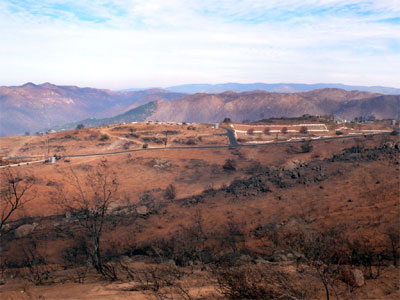
In the above two photos, although the clients cleared to bare ground for hundreds of feet in all directions, the structures were incinerated. This underscores the hypothesis of the laminar flow effect which results from removing all vegetation surrounding structures. There is nothing to break up nor moisten and cool the flow of embers.
Debris Dam
After a fire, there may be a potential for increased erosion, especially from all the ash and debris that result. At the wildland interface, one of the worst reactions is to seed the affected areas, especially with grasses. This usually results in worse erosion by the second year than if nothing had been done. The non-native weeds and grasses possess little long term slope holding ability and are ready to burn the following summer. Instead, a better strategy is to build debris dams across gullies as shown from T-posts and woven burned branches. The water can pass but the debris is held back. A little sandbagging and trenching around the perimeter of the yard will help direct water flows. And finally, if you must seed, then do it with poppies and lupines! At least it will be pretty and won’t mess up the ecology.

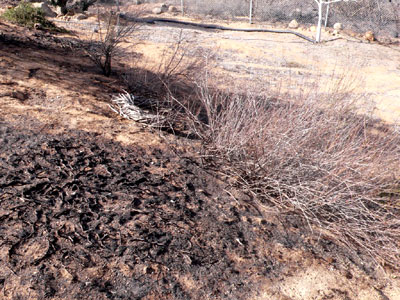


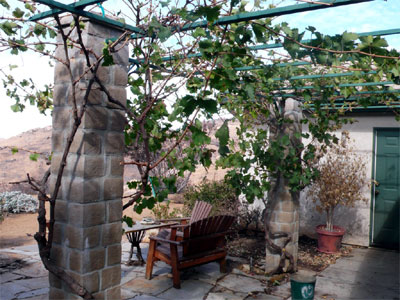

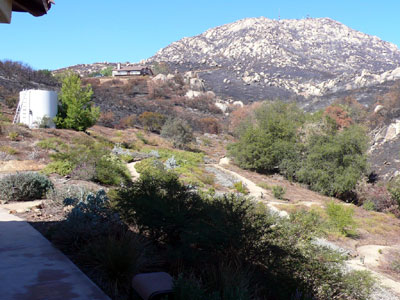
These next two photos illustrate the miracle of a property apparently saved by the landscape! The flames did not encroach into this Lyon’s Valley yard, stopping right at the edge (not even burning the mulch, nor thankfully, his expensive solar array!). As in the next two photos, this shows the high degree of fire resistance possible with a native landscape. The chaparral surrounding it, however, has experienced severe drought conditions for 8+ years. A neighbor down the street with another landscape designed by Cal Own saw similar results.
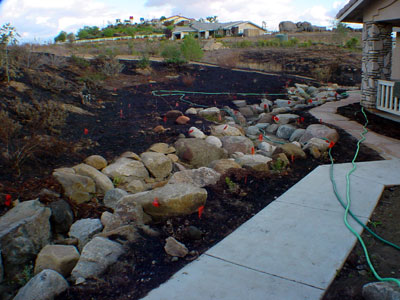

A fire inspector once ran tests on the shredded redwood mulch we use. He asked us what type of fire retardant we were using! None, of course. Redwood is naturally fire resistant, as long as the mulch is well consolidated. In these photos the client had done a bunch of planting not long before the fire. She decided to mark the new plants with plastic flags. As the mulch smoldered, there wasn’t enough heat to melt the flags! You can see how low the scorch marks are on the wall. Note the one flag that did melt resulted from a burning garden hose. There are unmelted flags all over the place.


The photo on the left illustrates the importance of site hygiene in preventing the spread of fire. All the weeds had been removed from the base of this Manzanita, so although the dead knot wood burned, the living bark and shrub came through absolutely fine. On the right is a very dramatic picture of a client’s back slope. Again, the natives scorched, but notice that there wasn’t even enough heat to ignite the wooden deck at the back of the house!